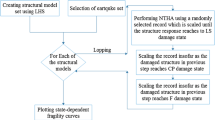Abstract
Considering uncertainty and dependence of performance limit states (PLSs), the study addresses a methodology to evaluate multidimensional fragility. The purpose is to identify the PLS uncertainty quantitatively. The dependence between each PLS parameters is also investigated. The limit state band is firstly proposed to describe the bi-dimensional case. Through interval estimation, the band area with a certain confidence level is determined. A reinforcement concrete bridge is used as example to illustrate the proposed approach for developing fragility curves. PLS threshold samples are obtained to formulate limit state function using incremental dynamic analysis. The study investigates the sensitivity of the method for fragility assessment when different confidence levels are considered. In addition, influence of correlation coefficient between PLSs is evaluated. Results show that a fragility interval is obtained with the introduction of limit state band. The interval length decreases as with the reduction of the confidence level. The probability of failure becomes smaller when the dependence between PLSs is ignored, which will result in overestimation of the structural seismic performance.
Similar content being viewed by others
References
Bojórquez, E. and Iervolino, I. (2011). “Spectral shape proxies and nonlinear structural response.” Soil Dynamics and Earthquake Engineering, Vol. 31, No. 7, pp. 996–1008, DOI: 10.1016/j.soildyn. 2011.03.006.
Casciati, F., Cimellaro, G., and Domaneschi, M. (2008). “Seismic reliability of a cable-stayed bridge retrofitted with hysteretic devices.” Computers & Structures, Vol. 86, No. 17-18, pp. 1769–1781, DOI: 10.1016/j.compstruc.2008.01.012.
Cimellaro, G. P., Reinhorn, A. M., Bruneau, M., and Rutenberg, A. (2006). “Multi-dimensional fragility of structure formulation and evaluation.” Rep. No. MCEER-06-0002, University at Buffalo, State University of New York: Multidisciplinary Center for Earthquake Engineering Research., New York.
Cimellaro, G. P. and Reinhorn, A. M. (2010). “Multidimensional performance limit state for hazard fragility functions.” Journal of Engineering Mechanics, Vol. 137, No. 1, DOI: 10.1061/(ASCE) EM.1943-7889.0000201.
Colangelo, F. (2012). “A simple model to include fuzziness in the seismic fragility curve and relevant effect compared with randomness.” Earthquake Engineering & Structural Dynamics, Vol. 41, No. 5, pp. 969–986, DOI: 10.1002/eqe.1169.
Colangelo, F. (2013a). “Probabilistic characterisation of an analytical fuzzy-random model for seismic fragility computation.” Structural Safety, Vol. 40, pp. 68–77, DOI: 10.1016/j.strusafe.2012.09.008.
Karim, K. R. and Yamazaki, F. (2001). “Effects of earthquake ground motions on fragility curves of highway bridge piers based on numerical simulation.” Earthquake Engineering & Structural Dynamics, Vol. 30, No. 12, pp. 1839–56, DOI: 10.1002/eqe.97.
Nazri, F. M. and Saruddin, S. N. A. (2015). “Seismic fragility curves for steel and reinforced concrete frames based on near-field and far-field ground motion records.” Arabian Journal for Science And Engineering, Vol. 40, No. 8, pp. 2301–2307, DOI: 10.1007/s13369-015-1758-y.
Pan, Y., Agrawal, A. K., and Ghosn, M. (2007). “Seismic fragility of continuous steel highway bridges in New York State.” Journal of Bridge Engineering, Vol. 12, No. 6, pp. 689–699, DOI: 10.1061/(ASCE)1084-0702(2007)12:6(689).
Pang, Y., Wu, X., Shen, G., and Yuan, W. (2014). “Seismic fragility analysis of cable-stayed bridges considering different sources of uncertainties.” Journal of Bridge Engineering, Vol. 19, No. 4, pp. 1–11, DOI: 10.1061/(ASCE)BE.1943-5592.0000565.
Priestley, M. J. N. and Calvi, G. M. (2003). “Direct displacement based seismic design of concrete bridges.” ACI International Conference on Seismic Bridge Design and Retrofit, La Jolla.
Riddell, R. (2007). “On ground motion intensity indices.” Earthquake Spectra, Vol. 23, No. 1, pp. 147–173, DOI: 10.1193/1.2424748.
Soyoz, S. (2007). Health monitoring of existing structures, University of California, Irvine.
Tubaldi, E., Barbato, M., and Dall'Asta, A. (2012). “Influence of model parameter uncertainty on seismic transverse response and vulnerability of steel-concrete composite bridges with dual load path.” Journal of Structural Engineering-ASCE, Vol. 138, No. 3, pp. 363–374, DOI: 10.1061/(ASCE)ST.1943-541X.0000456.
Author information
Authors and Affiliations
Corresponding author
Rights and permissions
About this article
Cite this article
Wang, Q., Wu, Z. & Liu, L. Uncertainty and dependence analysis of performance limit state for structural multidimensional fragility evaluation. KSCE J Civ Eng 21, 1386–1392 (2017). https://doi.org/10.1007/s12205-016-0983-6
Received:
Accepted:
Published:
Issue Date:
DOI: https://doi.org/10.1007/s12205-016-0983-6




